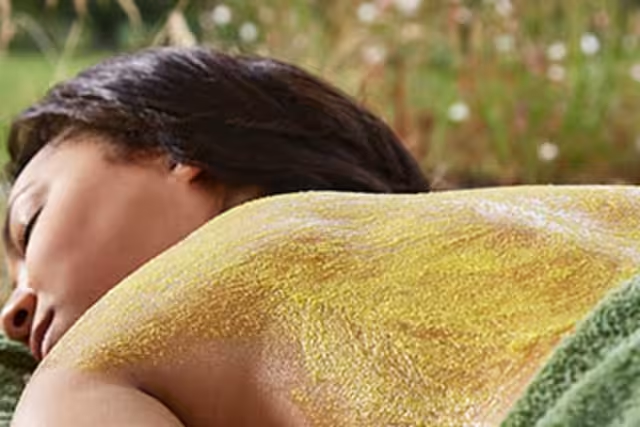What is a hammam treatment?
Part of the Spabreaks.com Spa Treatment Guides
Rooted in tradition, a hammam is a Middle Eastern wellbeing practice that dates back to the Roman and Byzantine eras and is essentially a steam bath experience (that might include a pool or a steam room) that can be shared with other people. It’s usually combined with cleansing rituals such as nourishing muds and exfoliations with showers to rinse products off in between.

What is a hammam?
Traditionally, hammams were public bathing facilities, health centres amongst the ancient Greeks and originating in Arabia. The principle is to offer cleansing, relaxation and a restorative experience. A hammam bath is both a treatment in its own right as well as the perfect way to prepare the body for a spa therapy such as a massage or facial.
Types of hammam are there?
Most commonly, hammam variations include a Turkish hammam, Turkish bath or a Moroccan hammam. However, today, many spas offer a variation on a hammam treatment, but often put their own twist on them. For example:
The Spa at Dolphin Square in central London, has a hammam that begins with a mint leaf foot ritual which adapts your body temperature for the steam room and starts the relaxation process. They recommend combining it with a treatment, for example applying a purifying rose scented rhassoul clay scrub to the face and body before giving you time to lie down on a heated bed in the steam room to relax and let the products work their magic in the heat. The exquisitely beautiful Coach House Health Club and Spa at Beaverbrook also has their own variation of the traditional hammam in the form of their English Bath House. Meanwhile at The Langley, they have a beautiful Elysium Luxury At Its Finest With Friends spa break, which includes a butler-led hammam enjoyed together as a group. Here you will be guided through the traditional journey of the cleanse with black soap, exfoliation with a kessa mitt, rhassoul lava clay hair treatment and a ceremonial misting of orange flower water. You will also have a small group personal training session in the beautiful Langley grounds, a one hour treatment journey experience each tailored to your individual needs and a Supreme Manicure or Pedicure.

What are the benefits of a hammam?
At its core, a hammam is a cleansing experience that detoxes the skin, relaxes the muscles, and generally helps you to unwind. It can be perfect at the end of a busy week, but it’s also a great way to prepare the skin and body to make the most out of other spa treatments like massages by opening up the pores and warming the muscles. Benefits include:
- Relaxation
- Rejuvenation
- Cleansing the skin
- Even helping to boost the immune system
- Increases circulation
- Opens pores
- Eases aching muscles
What happens in a hammam treatment?
Today, spas tend to put their own twist on hammam treatments, so that can vary enormously from one place to the next. However, the central feature is the steam bath, which helps to cleanse the skin and allows it to absorb the products that you put on it. Typically, the process might involve:
- A soak in a pool or sitting in a steam room
- Rinse and then apply exfoliating products
- Once you rinse these off you might then complete the ritual with a massage
Choose this if you want to…
A hammam is a great way to relax and unwind and make the most of spa treatments. Often combined with mud bath experiences, one of the lovely things about a hammam is that its shared practice and limited therapist input makes it perfect for enjoying with friends and partners, as well as being a gentle, guided introduction to spa treatments. Meanwhile, for seasoned spa goers, they provide a central feature from which to make the most of your time in a spa.

Average price of hammam ritual
As with all treatments, the cost of a hammam will vary depending on where you have it, the products that are used and the specific variations that the spa places on the treatment. As an average, you can expect to pay anything from £40 to £150 for a hammam in the UK, but some places will charge less and in some it will be more.

Hammam aftercare
After a hammam treatment it’s important to drink plenty of water or herbal tea to stay hydrated and spend some time in the spa’s relaxation room. It’s also a good idea to avoid caffeine and alcohol for a little while to prevent headaches and keep the good work of the treatment going. You might be given specific aftercare advice by your therapist depending on your own personal goals. It’s a nice idea to exfoliate once to twice a week at home to keep the results of the treatment lasting as long as possible.
What should I wear to a hammam?
In the UK it’s recommended/expected that you wear swimwear during a hammam ritual.
You Might Also Like

Saunas
Saunas are a wellbeing practice that have been used for many years in different cultures around the world. They are typically associated with Finnish and Estonian cultures, but are now fairly commonplace in gyms, spas and leisure facilities.
Read Our Guide
Body polishes
Body polishes and body scrubs can be invigorating, excellent skin prep before or after a holiday and can help with detox. As your skin is your largest detox assisting organ in the body, a body scrub can work wonders.
Read our guide
Massages for men
Spas have historically been associated with being places for women, but that is fast fading. Aside from the fact that we can all benefit from the health and wellbeing benefits of a spa, there are also specific spa treatments and experiences that have been tailored to men’s health.
Read our guide